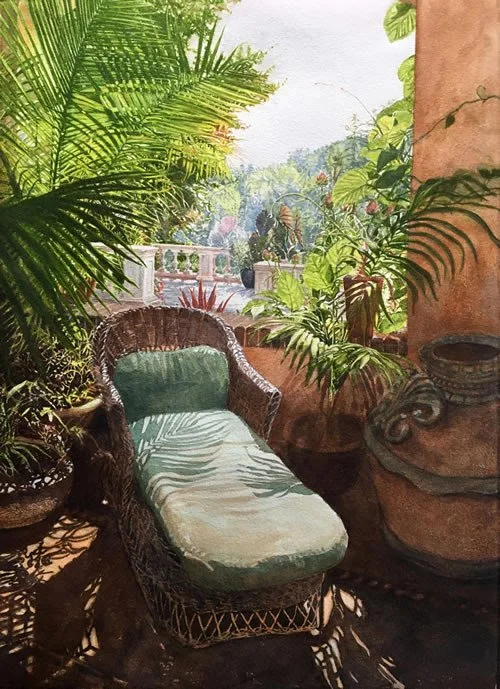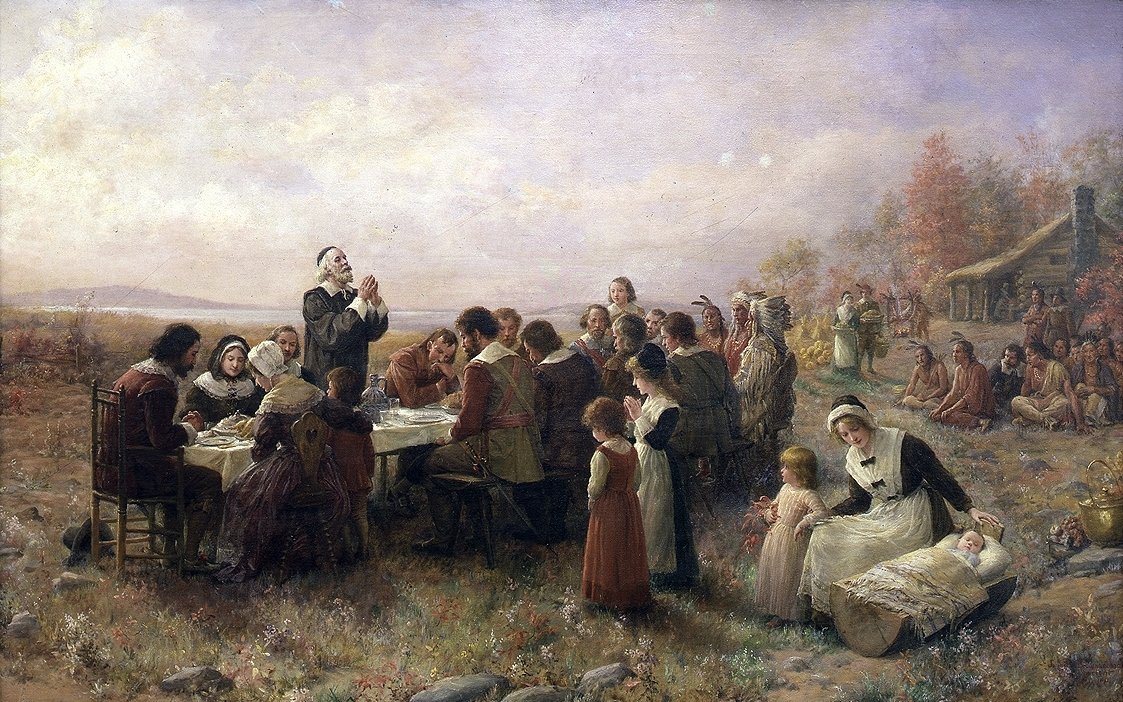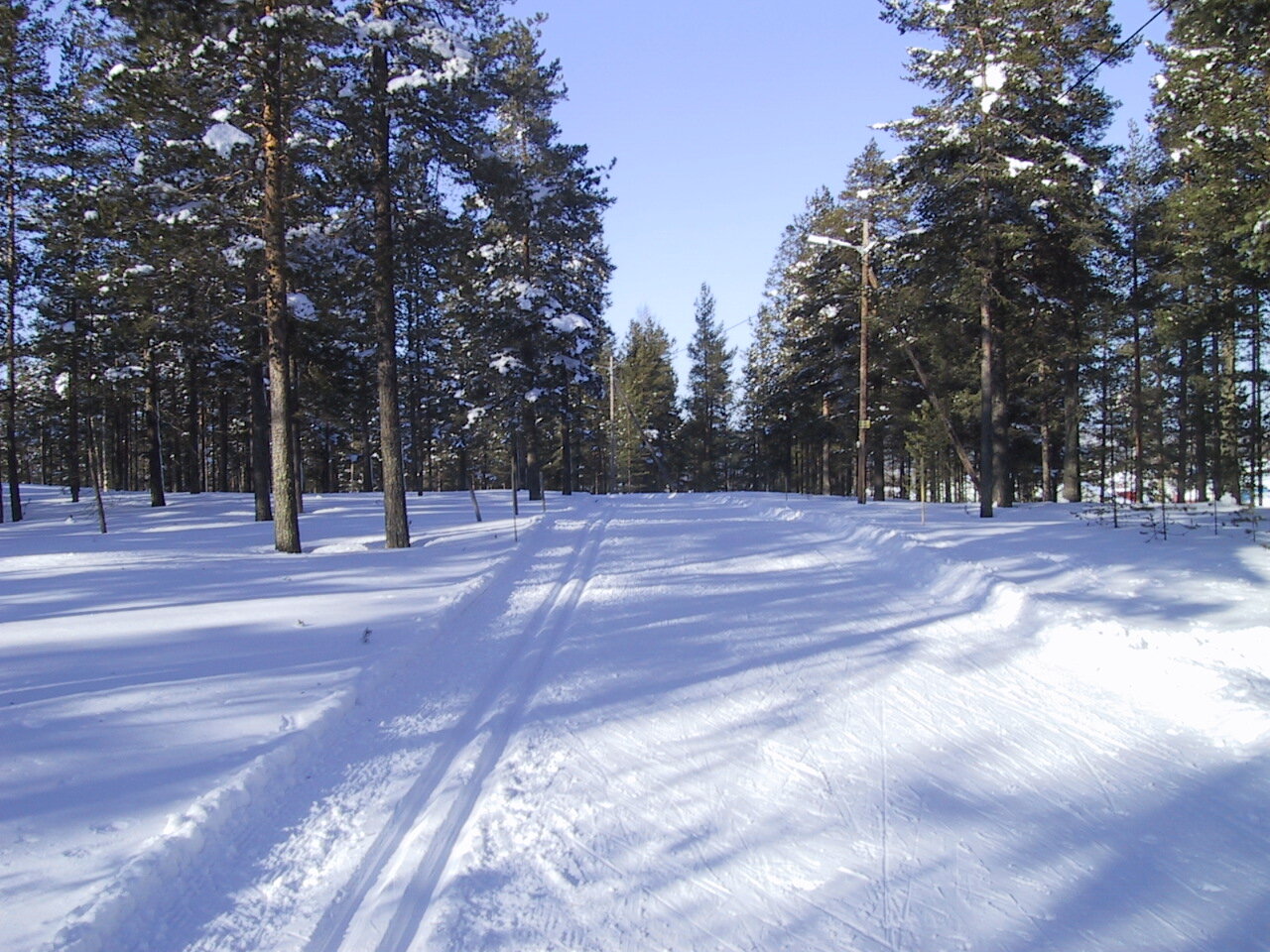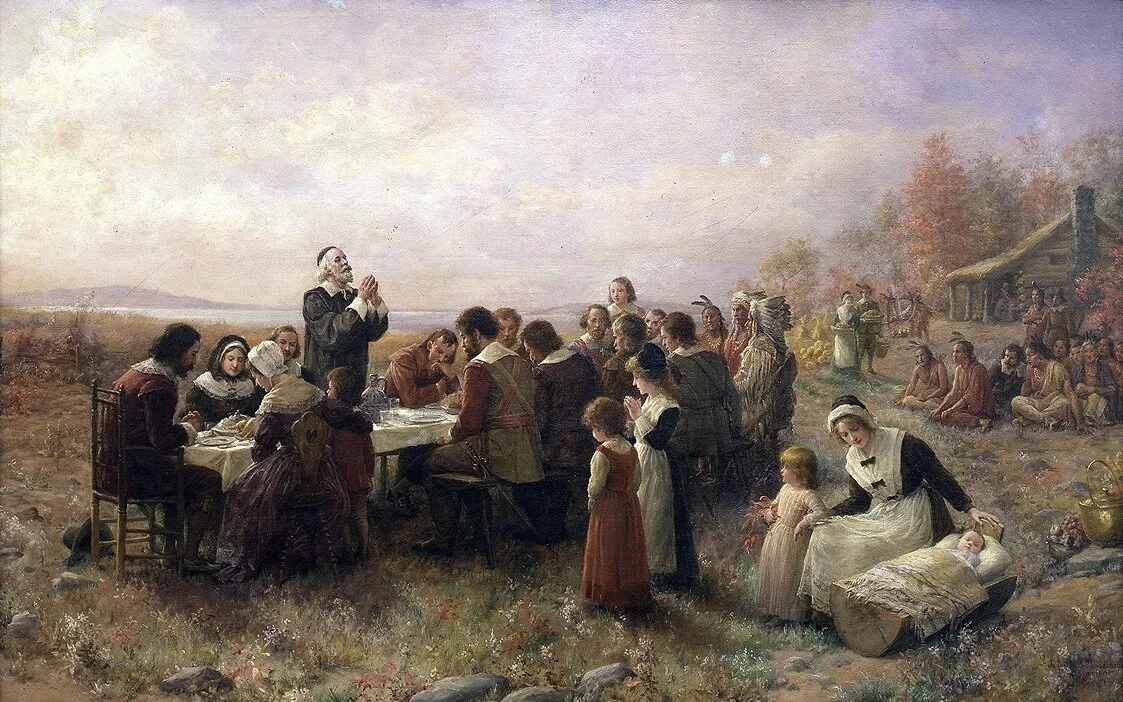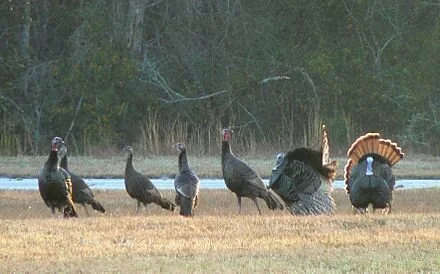
But beware the jungle
”Terrace Oasis” (watercolor), by West Barnstable, Mass.-based Brenda Bechtel, at the New England Watercolor Society Gallery’s 2023 “Celebrating New England’’ show, at the gallery, in Plymouth, Mass., through Sept. 7.
The gallery says:
“{The} exhibition … brings together 49 works from New England Watercolor Society members. The show is juried by Vladislav Yeliseyev, a Signature Member of the National Watercolor Society and the American Impressionist Society.’’
#Brenda Bechtel
#New England Watercolor Society
17th Century marketing
“The First Thanksgiving at Plymouth”, by Jennie Augusta Brownscombe (1914), in Pilgrim Hall Museum, Plymouth, Mass.
“Loving Cousin,
“At our arrival {from England} at New Plymouth, in New England, we found all our friends and planters in good health, though they were left sick and weak, with very small means; the Indians round about us peaceable and friendly; the country very pleasant and temperate, yielding naturally, of itself, great store of fruits, as vines of divers sorts, in great abundance. There is likewise walnuts, chestnuts, small nuts and plums, with much variety of flowers, roots and herbs, no less pleasant than wholesome and profitable. No place hath more gooseberries and strawberries, nor better. Timber of all sorts you have in England doth cover the land, that affords beasts of divers sorts, and great flocks of turkeys, quails, pigeons and partridges; many great lakes abounding with fish, fowl, beavers, and otters. The sea affords us great plenty of all excellent sorts of sea-fish, as the rivers and isles doth variety of wild fowl of most useful sorts. Mines we find, to our thinking; but neither the goodness nor quality we know. Better grain cannot be than the Indian corn, if we will plant it upon as good ground as a man need desire. We are all freeholders; the rent-day doth not trouble us; and all those good blessings we have, of which and what we list in their seasons for taking. Our company are, for the most part, very religious, honest people; the word of God sincerely taught us ever Sabbath; so that I know not any thing a contented mind can here want. I desire your friendly care to send my wife and children to me, where I wish all the friends I have in England; and so I rest.’’
“Your loving kinsman,
William Hilton”
The autumn of 1621 is supposed to have been when “The First Thanksgiving’’ took place— a cooperative affair between the Calvinist Pilgrims who had landed at what they named Plymouth the year before and some Wampanoags, those who has survived the epidemics of disease brought by English sailors and traders in Maine after 1600. These epidemics had killed most of the Native Americans in eastern New England before the Pilgrims arrived.
'By your leave'
I had for my winter evening walk—
No one at all with whom to talk,
But I had the cottages in a row
Up to their shining eyes in snow.
And I thought I had the folk within:
I had the sound of a violin;
I had a glimpse through curtain laces
Of youthful forms and youthful faces.
I had such company outward bound.
I went till there were no cottages found.
I turned and repented, but coming back
I saw no window but that was black.
Over the snow my creaking feet
Disturbed the slumbering village street
Like profanation, by your leave,
At ten o'clock of a winter eve.
Robert Frost (1874-1963) wrote this poem based on a walk he took in the winter of 2011-12 in Plymouth, N.H, where he had taken a job as a teacher at the Plymouth Normal School (now Plymouth State University). This was soon before he moved with his family to England, where he lived until 1915. He left little known but came back being considered a major poet.
Statue of Robert Frost at Plymouth State University.
Jim Hightower: Turkey and Thanksgiving confusions
“The First Thanksgiving at Plymouth “ (1914), by Jennie Augusta Brownscombe, at the Pilgrim Hall Museum, Plymouth, Mass. If they ate turkeys, they would have been members of the Eastern Wild Turkey subspecies seen below.
Via OtherWords.org
Let’s talk about turkey!
No, not the Butterball now pouting in the Oval Office. I’m talking about the real thing — the big bird, 46 million of which Americans will devour on Thanksgiving.
It was the Aztecs who first domesticated the gallopavo, but leave it to the Spanish conquistadores to “foul-up” the bird’s origins.
The Spanish declared the turkey to be related to the peacock — wrong! They also thought that the peacock originated in Turkey – wrong again! And they thought that Turkey was in Africa. You can see the Spanish colonists were pretty confused.
Actually, the origin of Thanksgiving itself is similarly confused.
The popular assumption is that it was first celebrated by the Mayflower immigrants and the Wampanoag natives at Plymouth in what is now called Massachusetts, 1621. They feasted on venison, neyhom (Wampanoag for gobblers), eels, mussels, corn and beer.
But wait, say Virginians, the first precursor to our annual November food-a-palooza was not in Massachusetts — the Thanksgiving feast originated down in Jamestown colony, back in 1608.
Whoa, there, hold your horses, pilgrims. Folks in El Paso, Texas, say that it all began way out there in 1598, when Spanish settlers sat down with people of the Piro and Manso tribes, gave thanks, then feasted on roasted duck, geese and fish.
“Ha!” says a Florida group, asserting the very, very first Thanksgiving happened in 1565, when the Spanish settlers of St. Augustine and friends from the Timucuan tribe chowed down on cocido — a stew of salt pork, garbanzo beans, and garlic — washing it all down with red wine.
Wherever it began, and whatever the purists claim is “official,” Thanksgiving today is as multicultural as America. So let’s enjoy — even if we’re in smaller groups or observing virtually this year.
Kick back, give thanks we’re in a country with such ethnic richness, and dive into your turkey rellenos, moo-shu turkey, turkey falafel, barbecued turkey.
Jim Hightower is a columnist and public speaker.
'Yearning for a new location'
Along Plymouth’s shoreline
“The night mist leaves us yearning for a new location
to things impossibly stationary,
the way they’d once float houses
made from dismantled ships, brass and timber,
from Plymouth, Massachusetts, across the sound
to White Horse Beach. You were only a boy.’’
— From “Floating Houses,’’ by David Wojahn
